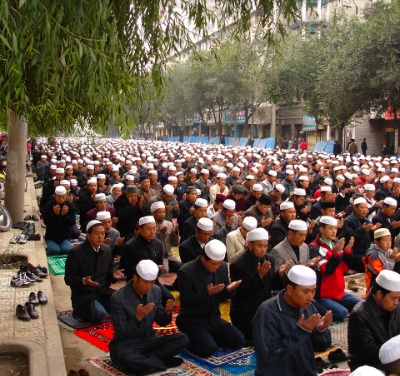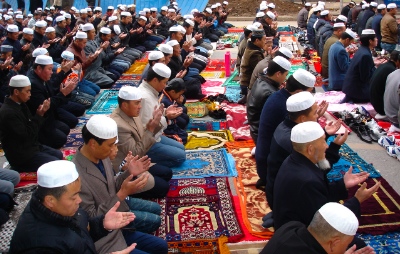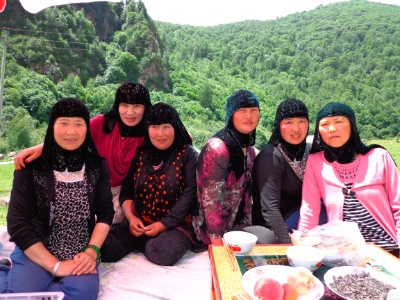Vancouverites will soon have a unique opportunity to hear a firsthand account of life among Chinese minority groups. Speaker John Allen has lived in China for 10 years and is currently engaged in doctoral research on ethnic and religious identity among China’s minorities, especially Chinese Muslims.
He will discuss his research findings and personal reflections. He will also explore the spiritual needs of those minorities and how the church can respond.
A guest of OMF International, Allen will speak April 8 (in English) and April 10 (in Mandarin) at Immanuel Christian Reformed Church in Richmond.
As an introduction to his presentation, Allen here provides an overview of the Muslim population in China, then offers a fascinating personal glimpse into the diversity within that population.
The presence of more than 30 million Muslims in China is a fact not commonly known in the West. Although this represents a small minority of the 1.3 billion people in China, it is a sizable Islamic community in global terms – indeed, it represents the third largest population of Muslims in the world not under Islamic government (India and Ethiopia being the larger two).
China identifies 56 different ‘nationalities’ as comprising the People’s Republic of China, with the Han being by far the largest and best known. But 10 of the nationalities are defined as Muslim ethnic minorities.
Of these, the Uyghur – a Turkish people in far west Xinjiang – are most well-known. A minority of the Uyghur are seeking independence from China, pointing to the fact that their territory was annexed by the Chinese in the 18th century. The tragedy is that this fascinating, lively people group is probably best known in the West for acts of terrorism and violence widely reported in the world’s press, such as the recent mass knife attack in Kunming.
The largest group are the Hui – a largely acculturated, Mandarin-speaking Chinese Muslim minority, numbering over 11 million people, scattered throughout China. Their ancestors were traders, merchants and soldiers from Persia and Arabia, who arrived and settled in China from 700 – 1300 AD, intermarrying with Chinese.
In the early days of Christian mission in China, Muslims were largely neglected, or at least they received no special treatment until the late 19th and early 20th century. By that stage, missionaries recognized that different methods and resources for sharing the gospel were needed, and a core of dedicated workers from different mission agencies, including the China Inland Mission (precursor to OMF International), developed.
Even so, work among Muslims was hard and unproductive; few turned to Christ. George Harris (Seattle, Washington), laboured in Gansu from 1917 – 1951, but saw only a handful of believers. George Hunter (Aberdeen, Scotland) pioneered work from 1906 – 1946 in Xinjiang, again seeing little fruit.
Even today, the Muslims of China remain largely unreached, although the number seeking to share the gospel with them has steadily increased, especially in the last 10 years. The Chinese church – perhaps in excess of 70 million people – is now beginning to engage with its Muslim neighbours.
But what is it like to live among these ‘minority’ people? What is the nature of their community life? Here is one example.
One city, one feast, three expressions of faith

Members of the Ikhwan movement, meeting outside the Dongguan mosque in Xining. This Chinese expression of the Muslim Brotherhood represents the dominant Muslim community in this part of China.
In August 2011, 150,000 white-capped Muslim men gather for the Eid prayer during the Feast of Fast-Breaking (Eid al-Fitr) on the main street of a major northwestern city in China. Traffic is stopped, the road is closed for two hours and loud speakers are erected all along the main East District thoroughfare as each unit (raka’at) of prayer flows like a human wave along the street.
Many observers, tourists and locals, take photographs, marvelling at the apparent unity of this vast community of Muslims from all over Qinghai Province, gathering together in one united expression of the community of all Muslims (Umma). It is truly one of the most impressive demonstrations of Muslim unity in China, and it happens every year outside the main Dongguan mosque in Xining, Qinghai.
Three blocks away, on a parallel street 500 metres away from the Dongguan mosque, an alternative gathering takes place. The men are fewer, about 10,000, and the Fast-Breaking prayer sounds different – more passionate and emotional. After the prayer finishes, all the men stay for about 20 minutes in private prayer (du’a), listening to further recitation over the loudspeakers. Why are these men not joining with the main body of the Muslim community just around the corner?
A further gathering of some 1,000 Muslim faithful meet for Fast-Breaking prayer in a third location (Wood Lane) – inside what looks like a mosque, though actually it is not a registered mosque, but a recently built ‘meeting place.’ The mullahs are dressed in full-length white gowns, and wear the Arabian style red-and-white-chequered headdress.
When I greet them (Asalam alaikum) they smile broadly and rapidly talk to me in Arabic. When I reply in Chinese, the smiles fade somewhat, and a guarded suspicion emerges. They warn me that the police are rapidly taking an interest in our conversation, and I should probably leave. Sure enough, three uniformed officers are casually approaching, so I smile and cycle away.
Why three separate groups?
Who are these three separate groups praying in three separate locations at the same time on this great feast day of Islam? Why are they not meeting together, in true demonstration of the united community that is such a key tenet of Islam? The answer to this has its roots in the complex history, Islamic theology and politics of northwest China and the Hui minority group.
The first group, meeting outside the Dongguan mosque represents the dominant Muslim community in this part of China – those aligned with the Ikhwan movement (al-Ikwan al-Muslimin). This Chinese expression of the Muslim Brotherhood has had links with the movement of the same name in Egypt, probably traced to the influence of Al Azhar university in Cairo through training Chinese imams. Of the 25 mosques in East Xining, only two are not affiliated with this order.
One of these two mosques, Yangjiaxiang, is where the second group of fast-breakers meet for prayer. This mosque has just been rebuilt in a grand Arabic style, and is known as the ‘Old Teaching’ mosque, frequented by those aligned to the original Qadim order, but also attended by many followers of the Sufi paths.
The unusual and distinctive Qur’anic reading style is a characteristic of this order, as is the heightened emotional involvement in worship. Indeed, the Sufis have the centre of their worship activities outside the mosque, at the three main tomb complexes in Xining, where the body of the founder of their path lies.
These tombs have all recently been rebuilt, and are increasingly prominent on the Xining skyline. Gathering around these tombs for ecstatic prayer, seeking to receive special blessing from Allah via their dead saint, and chanting special words revealed to their living shaykh are all sources of spiritual blessing.
The third group meeting in the new ‘mosque’ is the so-called White Sect, also known disparagingly by the wider Muslim community as the Three Raisers, owing to their practice of raising their hands three times during prayer to respect the three groups of ‘Pious Predecessors’ (al-Salaf al-Saleh) from earliest Islamic history. They refer to themselves as Salafi (al-Salafiyah), a word increasingly recognizable in the west and associated with Islamism or Islamic extremism.
Entry of Islam into a non-Muslim dominant society
 These three groups broadly delineate the historical development of Islam in Xining’s East District, and present a fascinating case study on the entry of Islam into a non-Muslim dominant society; a society with strong social cohesion, a dominant historical Confucian tradition and a current post-Communist atheistic capitalist ideology.
These three groups broadly delineate the historical development of Islam in Xining’s East District, and present a fascinating case study on the entry of Islam into a non-Muslim dominant society; a society with strong social cohesion, a dominant historical Confucian tradition and a current post-Communist atheistic capitalist ideology.
As one traces the historical development of Islam in China, we see firstly, the interaction of Islam with a ‘foreign’ Chinese culture; secondly, the beginning of an indigenization of Islam and the concurrent emergence of the Hui people during a period of political isolation associated with the Ming dynasty; thirdly, the comparatively open policy of the early Qing allowing the arrival of Sufi mendicant missionaries, and subsequent fracturing of Muslim society along theological lines (though often for political or economic reasons); followed finally over the last 120 years by repeated reform movements entering China seeking to reform Chinese Islam.
Each of these national-level Islamic movements has a unique local expression, and each movement has left behind a ‘remnant’ Islamic community, with its own particular brand of Islamic expression, with distinctive interpretations in the areas of practice and of the role of Islam in relating to the governing Han majority.



